Factors Influencing Obesity in Young Adults and Nurse Engagement
VerifiedAdded on 2021/01/02
|48
|13832
|235
Report
AI Summary
This report delves into the global issue of obesity, particularly focusing on its prevalence and impact on young adults. It examines the factors contributing to sedentary lifestyles, a key driver of obesity, including urbanization, family environment, screen time, and parental weight. The study highlights the crucial role of nurses in addressing this public health concern, emphasizing their ability to influence lifestyle changes through education and support. The report stresses the importance of nurses engaging in open conversations with teenagers and their parents, promoting healthy habits, and serving as role models. The findings underscore the need for comprehensive strategies to combat the obesity epidemic, including nurse-led interventions and government initiatives, to improve the health and well-being of young adults. The report also provides a detailed methodology that includes the research question, literature review, and findings, followed by a discussion of the implications for practice and conclusion.

Topic: An Exploration of obesity in young Adult and
Nurse Engagement in this Issue.
1
Nurse Engagement in this Issue.
1
Paraphrase This Document
Need a fresh take? Get an instant paraphrase of this document with our AI Paraphraser
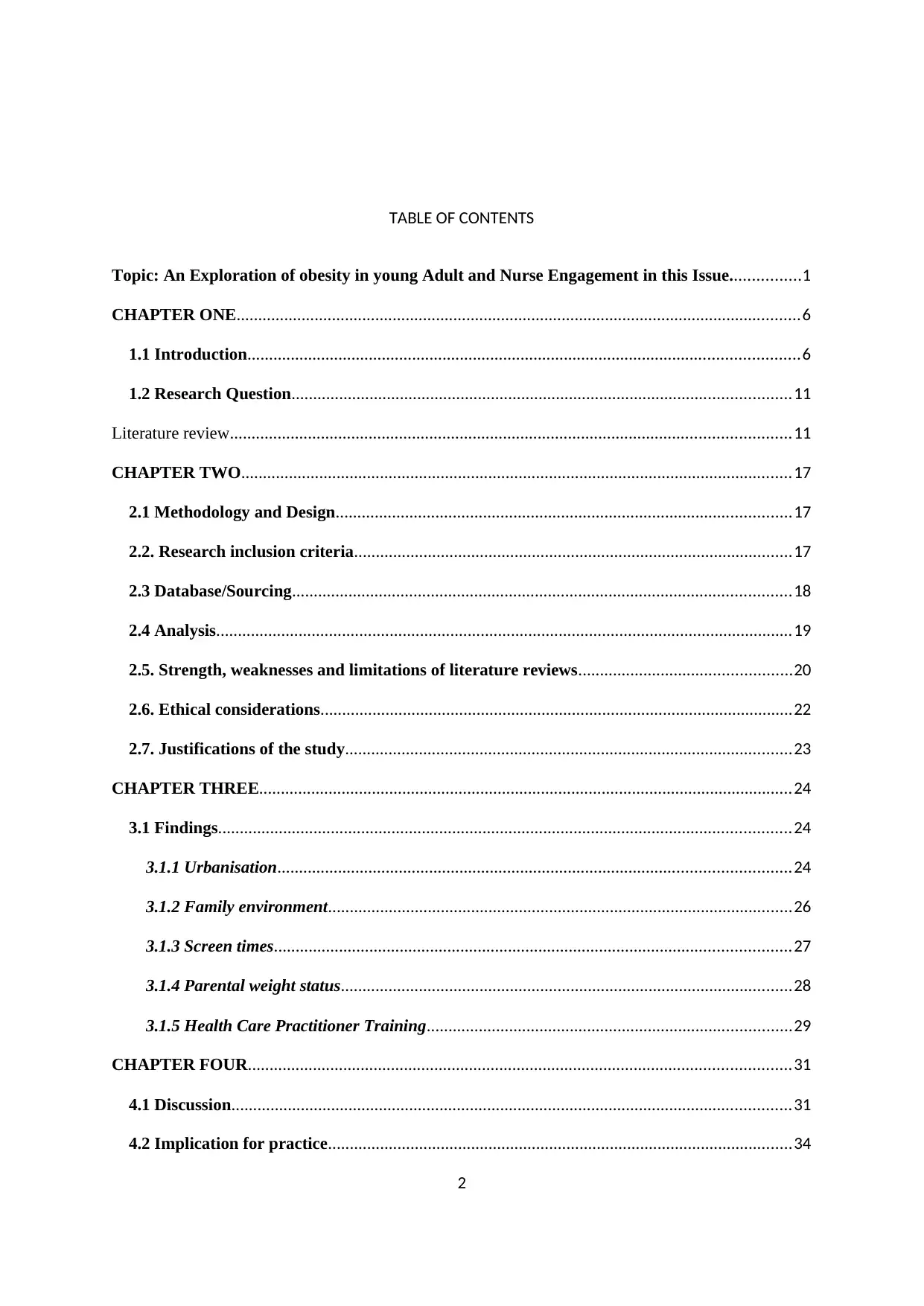
TABLE OF CONTENTS
Topic: An Exploration of obesity in young Adult and Nurse Engagement in this Issue................1
CHAPTER ONE..................................................................................................................................6
1.1 Introduction...............................................................................................................................6
1.2 Research Question...................................................................................................................11
Literature review.................................................................................................................................11
CHAPTER TWO...............................................................................................................................17
2.1 Methodology and Design.........................................................................................................17
2.2. Research inclusion criteria.....................................................................................................17
2.3 Database/Sourcing...................................................................................................................18
2.4 Analysis.....................................................................................................................................19
2.5. Strength, weaknesses and limitations of literature reviews.................................................20
2.6. Ethical considerations.............................................................................................................22
2.7. Justifications of the study.......................................................................................................23
CHAPTER THREE...........................................................................................................................24
3.1 Findings....................................................................................................................................24
3.1.1 Urbanisation......................................................................................................................24
3.1.2 Family environment...........................................................................................................26
3.1.3 Screen times.......................................................................................................................27
3.1.4 Parental weight status........................................................................................................28
3.1.5 Health Care Practitioner Training....................................................................................29
CHAPTER FOUR.............................................................................................................................31
4.1 Discussion.................................................................................................................................31
4.2 Implication for practice...........................................................................................................34
2
Topic: An Exploration of obesity in young Adult and Nurse Engagement in this Issue................1
CHAPTER ONE..................................................................................................................................6
1.1 Introduction...............................................................................................................................6
1.2 Research Question...................................................................................................................11
Literature review.................................................................................................................................11
CHAPTER TWO...............................................................................................................................17
2.1 Methodology and Design.........................................................................................................17
2.2. Research inclusion criteria.....................................................................................................17
2.3 Database/Sourcing...................................................................................................................18
2.4 Analysis.....................................................................................................................................19
2.5. Strength, weaknesses and limitations of literature reviews.................................................20
2.6. Ethical considerations.............................................................................................................22
2.7. Justifications of the study.......................................................................................................23
CHAPTER THREE...........................................................................................................................24
3.1 Findings....................................................................................................................................24
3.1.1 Urbanisation......................................................................................................................24
3.1.2 Family environment...........................................................................................................26
3.1.3 Screen times.......................................................................................................................27
3.1.4 Parental weight status........................................................................................................28
3.1.5 Health Care Practitioner Training....................................................................................29
CHAPTER FOUR.............................................................................................................................31
4.1 Discussion.................................................................................................................................31
4.2 Implication for practice...........................................................................................................34
2

6.1 Conclusion................................................................................................................................38
REFERENCE....................................................................................................................................40
3
REFERENCE....................................................................................................................................40
3
⊘ This is a preview!⊘
Do you want full access?
Subscribe today to unlock all pages.

Trusted by 1+ million students worldwide
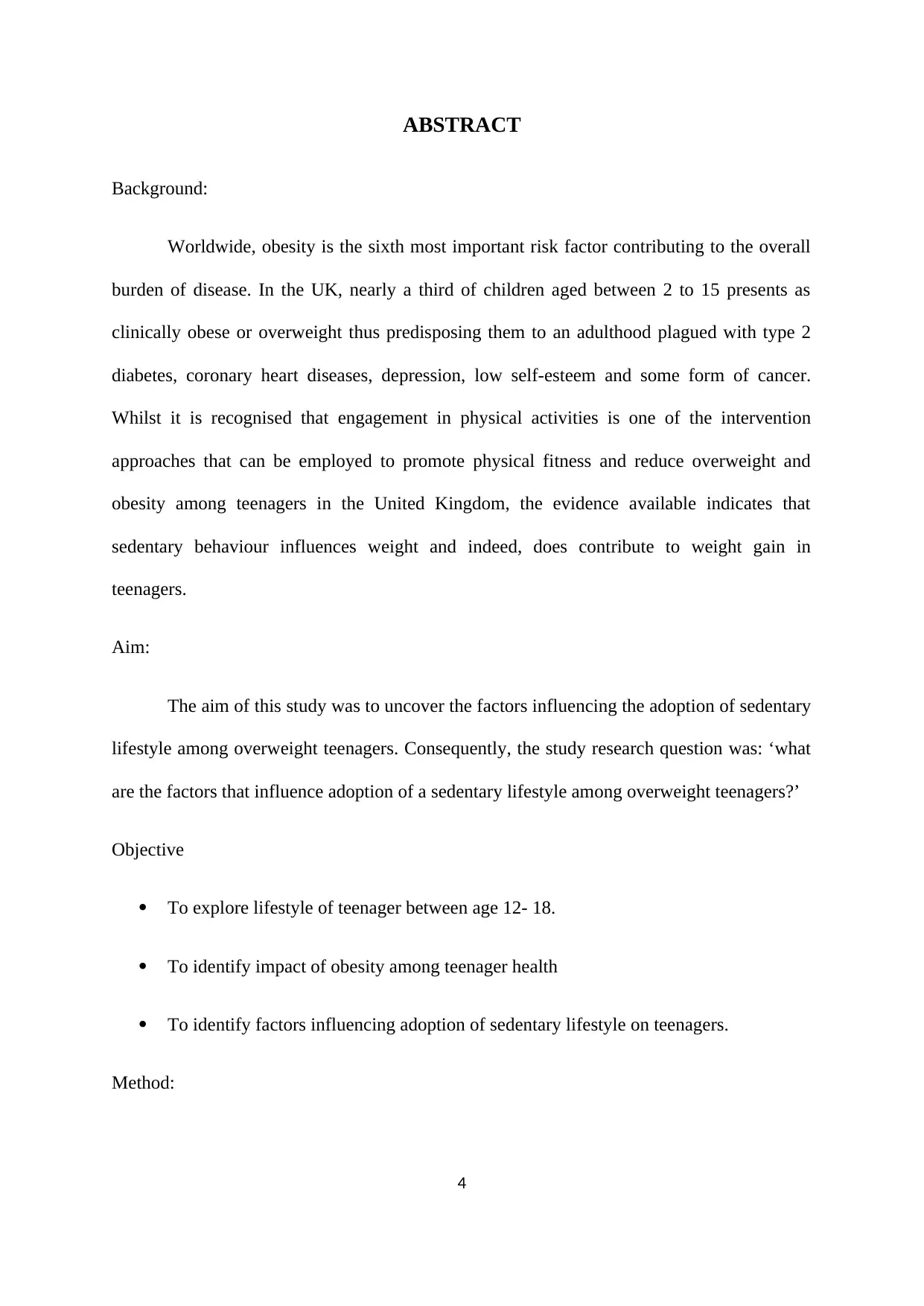
ABSTRACT
Background:
Worldwide, obesity is the sixth most important risk factor contributing to the overall
burden of disease. In the UK, nearly a third of children aged between 2 to 15 presents as
clinically obese or overweight thus predisposing them to an adulthood plagued with type 2
diabetes, coronary heart diseases, depression, low self-esteem and some form of cancer.
Whilst it is recognised that engagement in physical activities is one of the intervention
approaches that can be employed to promote physical fitness and reduce overweight and
obesity among teenagers in the United Kingdom, the evidence available indicates that
sedentary behaviour influences weight and indeed, does contribute to weight gain in
teenagers.
Aim:
The aim of this study was to uncover the factors influencing the adoption of sedentary
lifestyle among overweight teenagers. Consequently, the study research question was: ‘what
are the factors that influence adoption of a sedentary lifestyle among overweight teenagers?’
Objective
To explore lifestyle of teenager between age 12- 18.
To identify impact of obesity among teenager health
To identify factors influencing adoption of sedentary lifestyle on teenagers.
Method:
4
Background:
Worldwide, obesity is the sixth most important risk factor contributing to the overall
burden of disease. In the UK, nearly a third of children aged between 2 to 15 presents as
clinically obese or overweight thus predisposing them to an adulthood plagued with type 2
diabetes, coronary heart diseases, depression, low self-esteem and some form of cancer.
Whilst it is recognised that engagement in physical activities is one of the intervention
approaches that can be employed to promote physical fitness and reduce overweight and
obesity among teenagers in the United Kingdom, the evidence available indicates that
sedentary behaviour influences weight and indeed, does contribute to weight gain in
teenagers.
Aim:
The aim of this study was to uncover the factors influencing the adoption of sedentary
lifestyle among overweight teenagers. Consequently, the study research question was: ‘what
are the factors that influence adoption of a sedentary lifestyle among overweight teenagers?’
Objective
To explore lifestyle of teenager between age 12- 18.
To identify impact of obesity among teenager health
To identify factors influencing adoption of sedentary lifestyle on teenagers.
Method:
4
Paraphrase This Document
Need a fresh take? Get an instant paraphrase of this document with our AI Paraphraser

A research proposal was submitted prior to commencing this study. The study
employed a critical literature review theoretically underpinned by a seven-step model
consisting of three phases - exploration, interpretation and communication.
Findings:
Five key themes were identified as the factors that influence the adoption of a
sedentary lifestyle among overweight teenagers. These factors were urbanisation, family
environment, screen time, parental weight status and health care practitioner training.
Conclusion:
Nurses have a key role to play in addressing overweight and obesity in teenagers.
Accordingly, it is important that nurses are able to have an honest and open conversation with
teenagers and their parents on overweight and sedentary practices. This is likely to be the first
step in empowering teenagers to change sedentary practices.
5
employed a critical literature review theoretically underpinned by a seven-step model
consisting of three phases - exploration, interpretation and communication.
Findings:
Five key themes were identified as the factors that influence the adoption of a
sedentary lifestyle among overweight teenagers. These factors were urbanisation, family
environment, screen time, parental weight status and health care practitioner training.
Conclusion:
Nurses have a key role to play in addressing overweight and obesity in teenagers.
Accordingly, it is important that nurses are able to have an honest and open conversation with
teenagers and their parents on overweight and sedentary practices. This is likely to be the first
step in empowering teenagers to change sedentary practices.
5
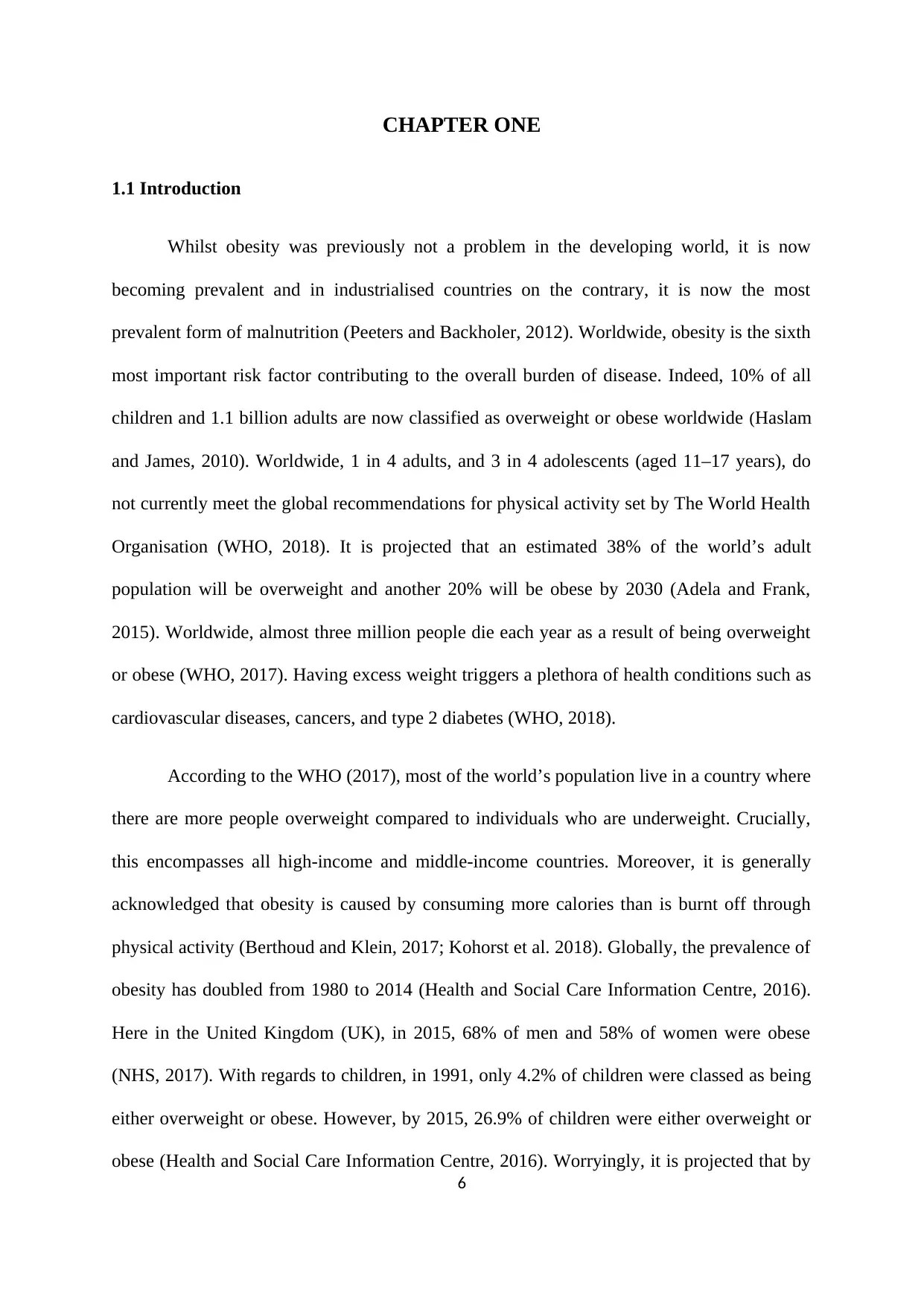
CHAPTER ONE
1.1 Introduction
Whilst obesity was previously not a problem in the developing world, it is now
becoming prevalent and in industrialised countries on the contrary, it is now the most
prevalent form of malnutrition (Peeters and Backholer, 2012). Worldwide, obesity is the sixth
most important risk factor contributing to the overall burden of disease. Indeed, 10% of all
children and 1.1 billion adults are now classified as overweight or obese worldwide (Haslam
and James, 2010). Worldwide, 1 in 4 adults, and 3 in 4 adolescents (aged 11–17 years), do
not currently meet the global recommendations for physical activity set by The World Health
Organisation (WHO, 2018). It is projected that an estimated 38% of the world’s adult
population will be overweight and another 20% will be obese by 2030 (Adela and Frank,
2015). Worldwide, almost three million people die each year as a result of being overweight
or obese (WHO, 2017). Having excess weight triggers a plethora of health conditions such as
cardiovascular diseases, cancers, and type 2 diabetes (WHO, 2018).
According to the WHO (2017), most of the world’s population live in a country where
there are more people overweight compared to individuals who are underweight. Crucially,
this encompasses all high-income and middle-income countries. Moreover, it is generally
acknowledged that obesity is caused by consuming more calories than is burnt off through
physical activity (Berthoud and Klein, 2017; Kohorst et al. 2018). Globally, the prevalence of
obesity has doubled from 1980 to 2014 (Health and Social Care Information Centre, 2016).
Here in the United Kingdom (UK), in 2015, 68% of men and 58% of women were obese
(NHS, 2017). With regards to children, in 1991, only 4.2% of children were classed as being
either overweight or obese. However, by 2015, 26.9% of children were either overweight or
obese (Health and Social Care Information Centre, 2016). Worryingly, it is projected that by
6
1.1 Introduction
Whilst obesity was previously not a problem in the developing world, it is now
becoming prevalent and in industrialised countries on the contrary, it is now the most
prevalent form of malnutrition (Peeters and Backholer, 2012). Worldwide, obesity is the sixth
most important risk factor contributing to the overall burden of disease. Indeed, 10% of all
children and 1.1 billion adults are now classified as overweight or obese worldwide (Haslam
and James, 2010). Worldwide, 1 in 4 adults, and 3 in 4 adolescents (aged 11–17 years), do
not currently meet the global recommendations for physical activity set by The World Health
Organisation (WHO, 2018). It is projected that an estimated 38% of the world’s adult
population will be overweight and another 20% will be obese by 2030 (Adela and Frank,
2015). Worldwide, almost three million people die each year as a result of being overweight
or obese (WHO, 2017). Having excess weight triggers a plethora of health conditions such as
cardiovascular diseases, cancers, and type 2 diabetes (WHO, 2018).
According to the WHO (2017), most of the world’s population live in a country where
there are more people overweight compared to individuals who are underweight. Crucially,
this encompasses all high-income and middle-income countries. Moreover, it is generally
acknowledged that obesity is caused by consuming more calories than is burnt off through
physical activity (Berthoud and Klein, 2017; Kohorst et al. 2018). Globally, the prevalence of
obesity has doubled from 1980 to 2014 (Health and Social Care Information Centre, 2016).
Here in the United Kingdom (UK), in 2015, 68% of men and 58% of women were obese
(NHS, 2017). With regards to children, in 1991, only 4.2% of children were classed as being
either overweight or obese. However, by 2015, 26.9% of children were either overweight or
obese (Health and Social Care Information Centre, 2016). Worryingly, it is projected that by
6
⊘ This is a preview!⊘
Do you want full access?
Subscribe today to unlock all pages.

Trusted by 1+ million students worldwide
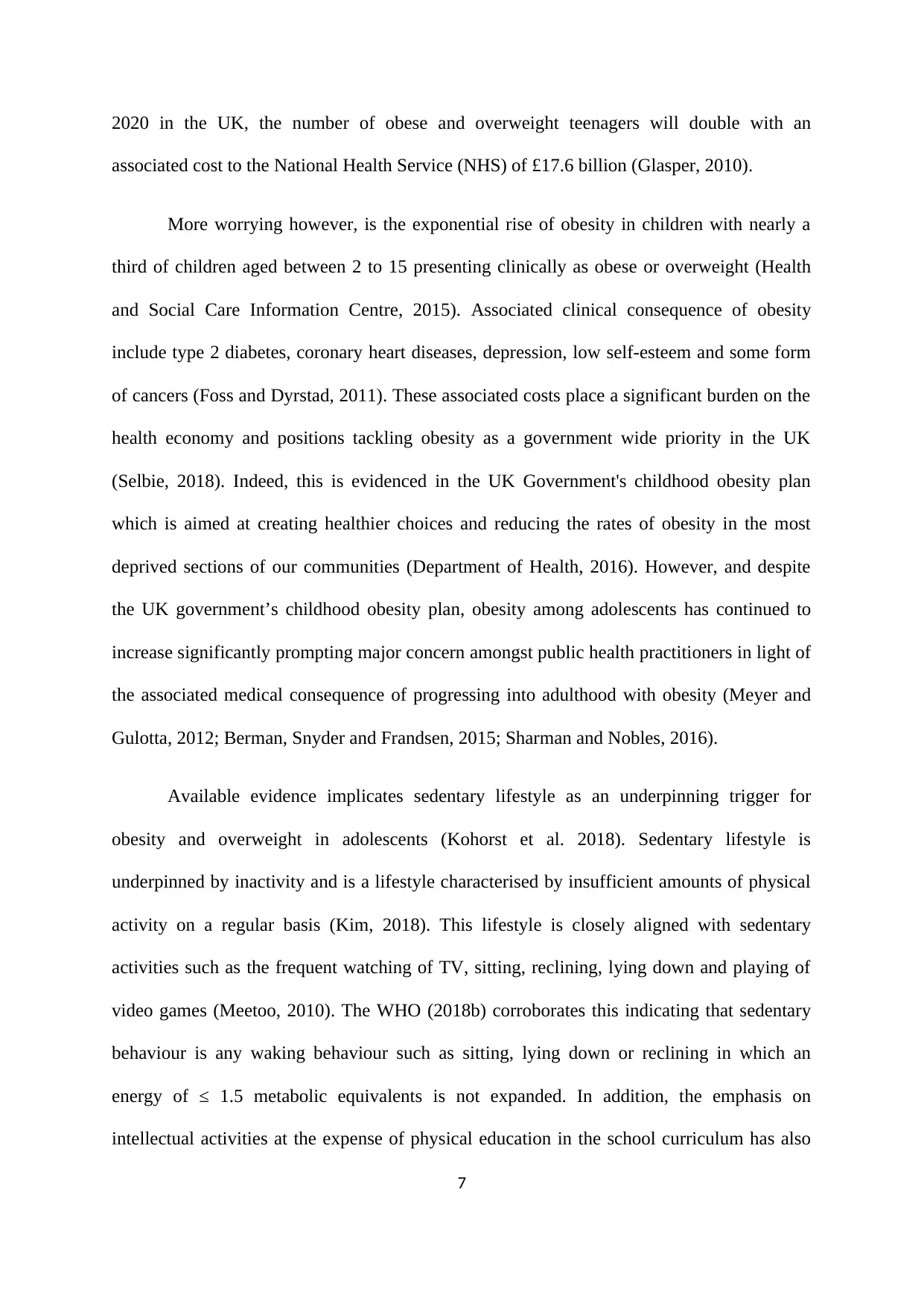
2020 in the UK, the number of obese and overweight teenagers will double with an
associated cost to the National Health Service (NHS) of £17.6 billion (Glasper, 2010).
More worrying however, is the exponential rise of obesity in children with nearly a
third of children aged between 2 to 15 presenting clinically as obese or overweight (Health
and Social Care Information Centre, 2015). Associated clinical consequence of obesity
include type 2 diabetes, coronary heart diseases, depression, low self-esteem and some form
of cancers (Foss and Dyrstad, 2011). These associated costs place a significant burden on the
health economy and positions tackling obesity as a government wide priority in the UK
(Selbie, 2018). Indeed, this is evidenced in the UK Government's childhood obesity plan
which is aimed at creating healthier choices and reducing the rates of obesity in the most
deprived sections of our communities (Department of Health, 2016). However, and despite
the UK government’s childhood obesity plan, obesity among adolescents has continued to
increase significantly prompting major concern amongst public health practitioners in light of
the associated medical consequence of progressing into adulthood with obesity (Meyer and
Gulotta, 2012; Berman, Snyder and Frandsen, 2015; Sharman and Nobles, 2016).
Available evidence implicates sedentary lifestyle as an underpinning trigger for
obesity and overweight in adolescents (Kohorst et al. 2018). Sedentary lifestyle is
underpinned by inactivity and is a lifestyle characterised by insufficient amounts of physical
activity on a regular basis (Kim, 2018). This lifestyle is closely aligned with sedentary
activities such as the frequent watching of TV, sitting, reclining, lying down and playing of
video games (Meetoo, 2010). The WHO (2018b) corroborates this indicating that sedentary
behaviour is any waking behaviour such as sitting, lying down or reclining in which an
energy of ≤ 1.5 metabolic equivalents is not expanded. In addition, the emphasis on
intellectual activities at the expense of physical education in the school curriculum has also
7
associated cost to the National Health Service (NHS) of £17.6 billion (Glasper, 2010).
More worrying however, is the exponential rise of obesity in children with nearly a
third of children aged between 2 to 15 presenting clinically as obese or overweight (Health
and Social Care Information Centre, 2015). Associated clinical consequence of obesity
include type 2 diabetes, coronary heart diseases, depression, low self-esteem and some form
of cancers (Foss and Dyrstad, 2011). These associated costs place a significant burden on the
health economy and positions tackling obesity as a government wide priority in the UK
(Selbie, 2018). Indeed, this is evidenced in the UK Government's childhood obesity plan
which is aimed at creating healthier choices and reducing the rates of obesity in the most
deprived sections of our communities (Department of Health, 2016). However, and despite
the UK government’s childhood obesity plan, obesity among adolescents has continued to
increase significantly prompting major concern amongst public health practitioners in light of
the associated medical consequence of progressing into adulthood with obesity (Meyer and
Gulotta, 2012; Berman, Snyder and Frandsen, 2015; Sharman and Nobles, 2016).
Available evidence implicates sedentary lifestyle as an underpinning trigger for
obesity and overweight in adolescents (Kohorst et al. 2018). Sedentary lifestyle is
underpinned by inactivity and is a lifestyle characterised by insufficient amounts of physical
activity on a regular basis (Kim, 2018). This lifestyle is closely aligned with sedentary
activities such as the frequent watching of TV, sitting, reclining, lying down and playing of
video games (Meetoo, 2010). The WHO (2018b) corroborates this indicating that sedentary
behaviour is any waking behaviour such as sitting, lying down or reclining in which an
energy of ≤ 1.5 metabolic equivalents is not expanded. In addition, the emphasis on
intellectual activities at the expense of physical education in the school curriculum has also
7
Paraphrase This Document
Need a fresh take? Get an instant paraphrase of this document with our AI Paraphraser
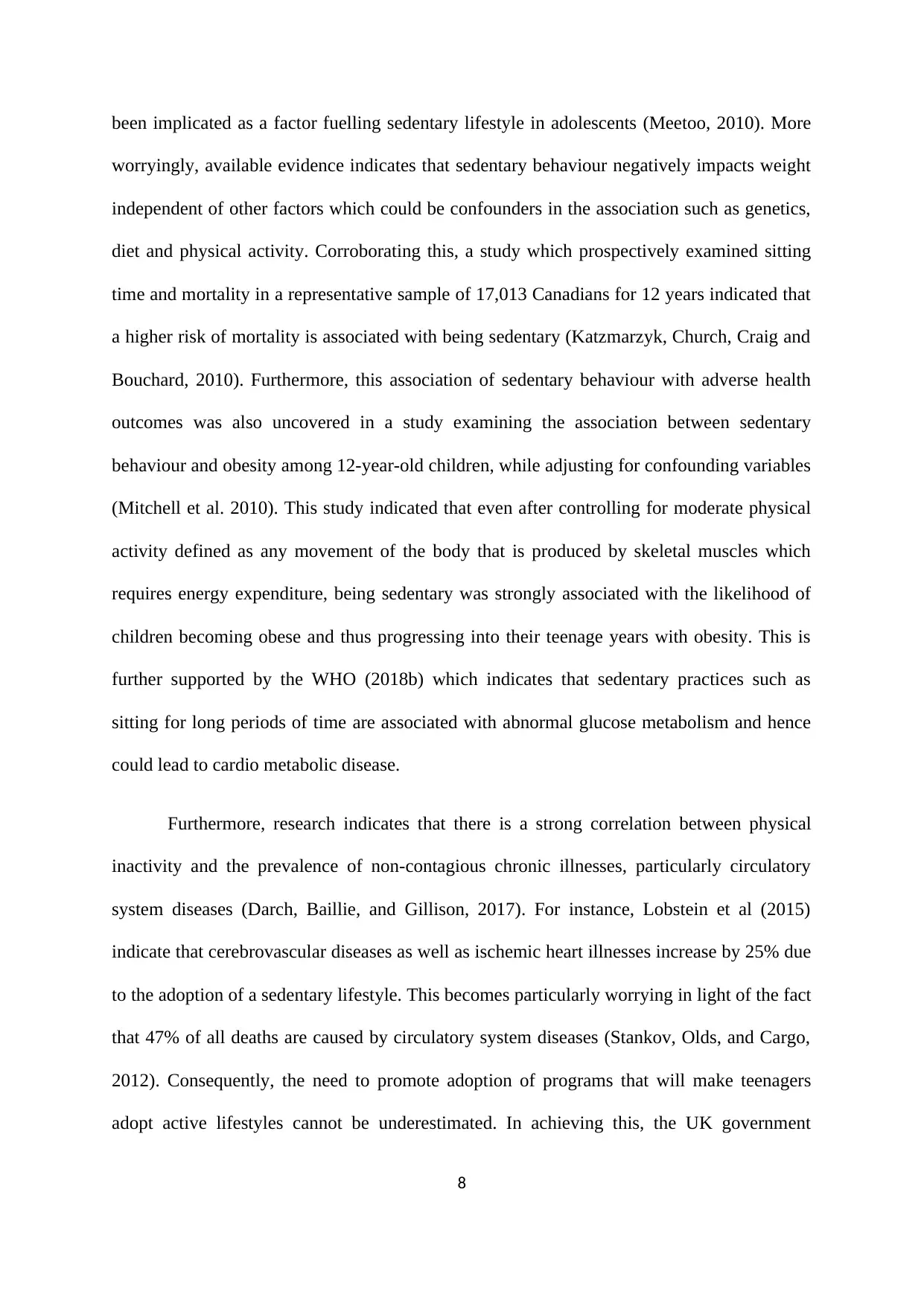
been implicated as a factor fuelling sedentary lifestyle in adolescents (Meetoo, 2010). More
worryingly, available evidence indicates that sedentary behaviour negatively impacts weight
independent of other factors which could be confounders in the association such as genetics,
diet and physical activity. Corroborating this, a study which prospectively examined sitting
time and mortality in a representative sample of 17,013 Canadians for 12 years indicated that
a higher risk of mortality is associated with being sedentary (Katzmarzyk, Church, Craig and
Bouchard, 2010). Furthermore, this association of sedentary behaviour with adverse health
outcomes was also uncovered in a study examining the association between sedentary
behaviour and obesity among 12-year-old children, while adjusting for confounding variables
(Mitchell et al. 2010). This study indicated that even after controlling for moderate physical
activity defined as any movement of the body that is produced by skeletal muscles which
requires energy expenditure, being sedentary was strongly associated with the likelihood of
children becoming obese and thus progressing into their teenage years with obesity. This is
further supported by the WHO (2018b) which indicates that sedentary practices such as
sitting for long periods of time are associated with abnormal glucose metabolism and hence
could lead to cardio metabolic disease.
Furthermore, research indicates that there is a strong correlation between physical
inactivity and the prevalence of non-contagious chronic illnesses, particularly circulatory
system diseases (Darch, Baillie, and Gillison, 2017). For instance, Lobstein et al (2015)
indicate that cerebrovascular diseases as well as ischemic heart illnesses increase by 25% due
to the adoption of a sedentary lifestyle. This becomes particularly worrying in light of the fact
that 47% of all deaths are caused by circulatory system diseases (Stankov, Olds, and Cargo,
2012). Consequently, the need to promote adoption of programs that will make teenagers
adopt active lifestyles cannot be underestimated. In achieving this, the UK government
8
worryingly, available evidence indicates that sedentary behaviour negatively impacts weight
independent of other factors which could be confounders in the association such as genetics,
diet and physical activity. Corroborating this, a study which prospectively examined sitting
time and mortality in a representative sample of 17,013 Canadians for 12 years indicated that
a higher risk of mortality is associated with being sedentary (Katzmarzyk, Church, Craig and
Bouchard, 2010). Furthermore, this association of sedentary behaviour with adverse health
outcomes was also uncovered in a study examining the association between sedentary
behaviour and obesity among 12-year-old children, while adjusting for confounding variables
(Mitchell et al. 2010). This study indicated that even after controlling for moderate physical
activity defined as any movement of the body that is produced by skeletal muscles which
requires energy expenditure, being sedentary was strongly associated with the likelihood of
children becoming obese and thus progressing into their teenage years with obesity. This is
further supported by the WHO (2018b) which indicates that sedentary practices such as
sitting for long periods of time are associated with abnormal glucose metabolism and hence
could lead to cardio metabolic disease.
Furthermore, research indicates that there is a strong correlation between physical
inactivity and the prevalence of non-contagious chronic illnesses, particularly circulatory
system diseases (Darch, Baillie, and Gillison, 2017). For instance, Lobstein et al (2015)
indicate that cerebrovascular diseases as well as ischemic heart illnesses increase by 25% due
to the adoption of a sedentary lifestyle. This becomes particularly worrying in light of the fact
that 47% of all deaths are caused by circulatory system diseases (Stankov, Olds, and Cargo,
2012). Consequently, the need to promote adoption of programs that will make teenagers
adopt active lifestyles cannot be underestimated. In achieving this, the UK government
8
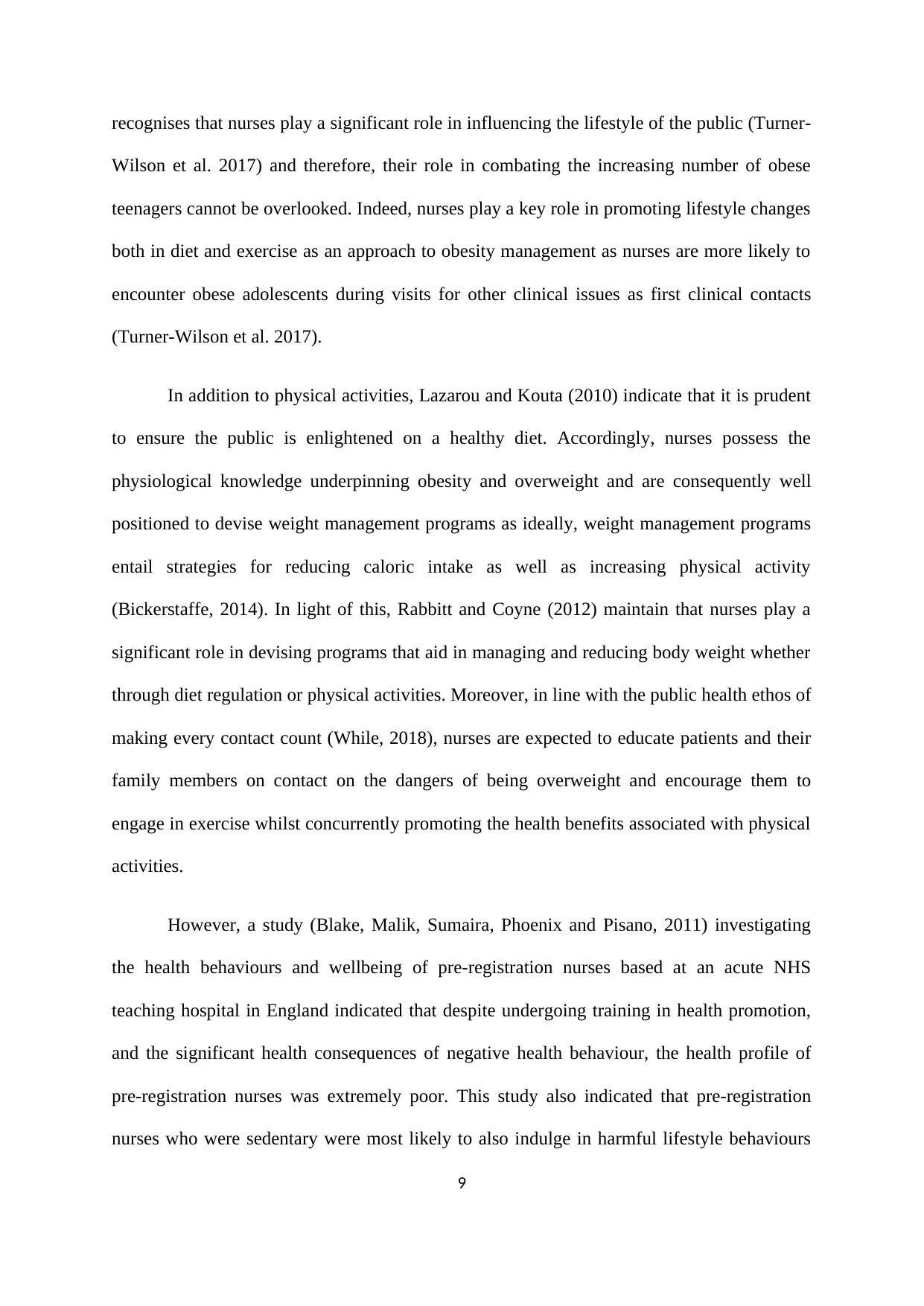
recognises that nurses play a significant role in influencing the lifestyle of the public (Turner-
Wilson et al. 2017) and therefore, their role in combating the increasing number of obese
teenagers cannot be overlooked. Indeed, nurses play a key role in promoting lifestyle changes
both in diet and exercise as an approach to obesity management as nurses are more likely to
encounter obese adolescents during visits for other clinical issues as first clinical contacts
(Turner-Wilson et al. 2017).
In addition to physical activities, Lazarou and Kouta (2010) indicate that it is prudent
to ensure the public is enlightened on a healthy diet. Accordingly, nurses possess the
physiological knowledge underpinning obesity and overweight and are consequently well
positioned to devise weight management programs as ideally, weight management programs
entail strategies for reducing caloric intake as well as increasing physical activity
(Bickerstaffe, 2014). In light of this, Rabbitt and Coyne (2012) maintain that nurses play a
significant role in devising programs that aid in managing and reducing body weight whether
through diet regulation or physical activities. Moreover, in line with the public health ethos of
making every contact count (While, 2018), nurses are expected to educate patients and their
family members on contact on the dangers of being overweight and encourage them to
engage in exercise whilst concurrently promoting the health benefits associated with physical
activities.
However, a study (Blake, Malik, Sumaira, Phoenix and Pisano, 2011) investigating
the health behaviours and wellbeing of pre-registration nurses based at an acute NHS
teaching hospital in England indicated that despite undergoing training in health promotion,
and the significant health consequences of negative health behaviour, the health profile of
pre-registration nurses was extremely poor. This study also indicated that pre-registration
nurses who were sedentary were most likely to also indulge in harmful lifestyle behaviours
9
Wilson et al. 2017) and therefore, their role in combating the increasing number of obese
teenagers cannot be overlooked. Indeed, nurses play a key role in promoting lifestyle changes
both in diet and exercise as an approach to obesity management as nurses are more likely to
encounter obese adolescents during visits for other clinical issues as first clinical contacts
(Turner-Wilson et al. 2017).
In addition to physical activities, Lazarou and Kouta (2010) indicate that it is prudent
to ensure the public is enlightened on a healthy diet. Accordingly, nurses possess the
physiological knowledge underpinning obesity and overweight and are consequently well
positioned to devise weight management programs as ideally, weight management programs
entail strategies for reducing caloric intake as well as increasing physical activity
(Bickerstaffe, 2014). In light of this, Rabbitt and Coyne (2012) maintain that nurses play a
significant role in devising programs that aid in managing and reducing body weight whether
through diet regulation or physical activities. Moreover, in line with the public health ethos of
making every contact count (While, 2018), nurses are expected to educate patients and their
family members on contact on the dangers of being overweight and encourage them to
engage in exercise whilst concurrently promoting the health benefits associated with physical
activities.
However, a study (Blake, Malik, Sumaira, Phoenix and Pisano, 2011) investigating
the health behaviours and wellbeing of pre-registration nurses based at an acute NHS
teaching hospital in England indicated that despite undergoing training in health promotion,
and the significant health consequences of negative health behaviour, the health profile of
pre-registration nurses was extremely poor. This study also indicated that pre-registration
nurses who were sedentary were most likely to also indulge in harmful lifestyle behaviours
9
⊘ This is a preview!⊘
Do you want full access?
Subscribe today to unlock all pages.

Trusted by 1+ million students worldwide
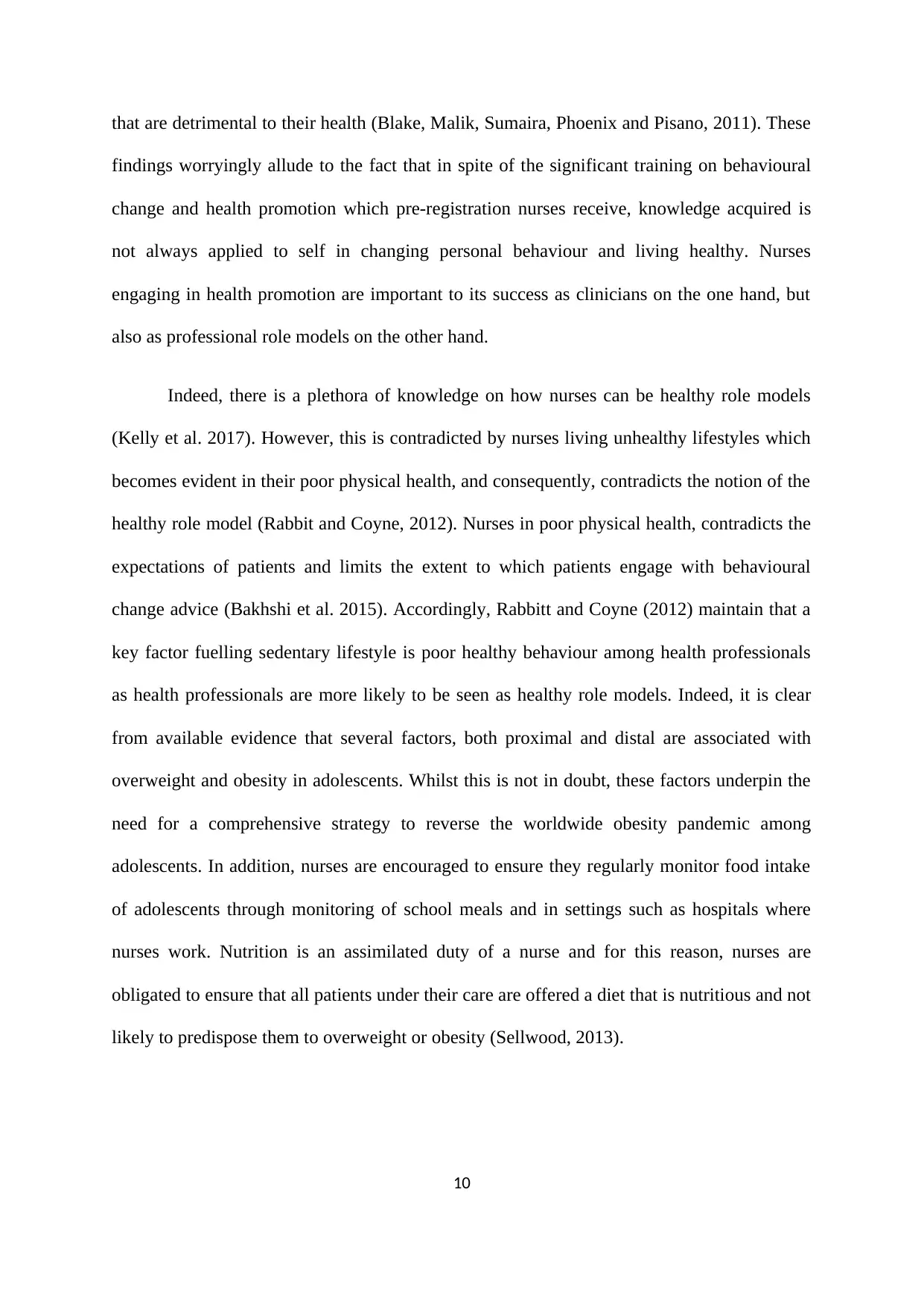
that are detrimental to their health (Blake, Malik, Sumaira, Phoenix and Pisano, 2011). These
findings worryingly allude to the fact that in spite of the significant training on behavioural
change and health promotion which pre-registration nurses receive, knowledge acquired is
not always applied to self in changing personal behaviour and living healthy. Nurses
engaging in health promotion are important to its success as clinicians on the one hand, but
also as professional role models on the other hand.
Indeed, there is a plethora of knowledge on how nurses can be healthy role models
(Kelly et al. 2017). However, this is contradicted by nurses living unhealthy lifestyles which
becomes evident in their poor physical health, and consequently, contradicts the notion of the
healthy role model (Rabbit and Coyne, 2012). Nurses in poor physical health, contradicts the
expectations of patients and limits the extent to which patients engage with behavioural
change advice (Bakhshi et al. 2015). Accordingly, Rabbitt and Coyne (2012) maintain that a
key factor fuelling sedentary lifestyle is poor healthy behaviour among health professionals
as health professionals are more likely to be seen as healthy role models. Indeed, it is clear
from available evidence that several factors, both proximal and distal are associated with
overweight and obesity in adolescents. Whilst this is not in doubt, these factors underpin the
need for a comprehensive strategy to reverse the worldwide obesity pandemic among
adolescents. In addition, nurses are encouraged to ensure they regularly monitor food intake
of adolescents through monitoring of school meals and in settings such as hospitals where
nurses work. Nutrition is an assimilated duty of a nurse and for this reason, nurses are
obligated to ensure that all patients under their care are offered a diet that is nutritious and not
likely to predispose them to overweight or obesity (Sellwood, 2013).
10
findings worryingly allude to the fact that in spite of the significant training on behavioural
change and health promotion which pre-registration nurses receive, knowledge acquired is
not always applied to self in changing personal behaviour and living healthy. Nurses
engaging in health promotion are important to its success as clinicians on the one hand, but
also as professional role models on the other hand.
Indeed, there is a plethora of knowledge on how nurses can be healthy role models
(Kelly et al. 2017). However, this is contradicted by nurses living unhealthy lifestyles which
becomes evident in their poor physical health, and consequently, contradicts the notion of the
healthy role model (Rabbit and Coyne, 2012). Nurses in poor physical health, contradicts the
expectations of patients and limits the extent to which patients engage with behavioural
change advice (Bakhshi et al. 2015). Accordingly, Rabbitt and Coyne (2012) maintain that a
key factor fuelling sedentary lifestyle is poor healthy behaviour among health professionals
as health professionals are more likely to be seen as healthy role models. Indeed, it is clear
from available evidence that several factors, both proximal and distal are associated with
overweight and obesity in adolescents. Whilst this is not in doubt, these factors underpin the
need for a comprehensive strategy to reverse the worldwide obesity pandemic among
adolescents. In addition, nurses are encouraged to ensure they regularly monitor food intake
of adolescents through monitoring of school meals and in settings such as hospitals where
nurses work. Nutrition is an assimilated duty of a nurse and for this reason, nurses are
obligated to ensure that all patients under their care are offered a diet that is nutritious and not
likely to predispose them to overweight or obesity (Sellwood, 2013).
10
Paraphrase This Document
Need a fresh take? Get an instant paraphrase of this document with our AI Paraphraser
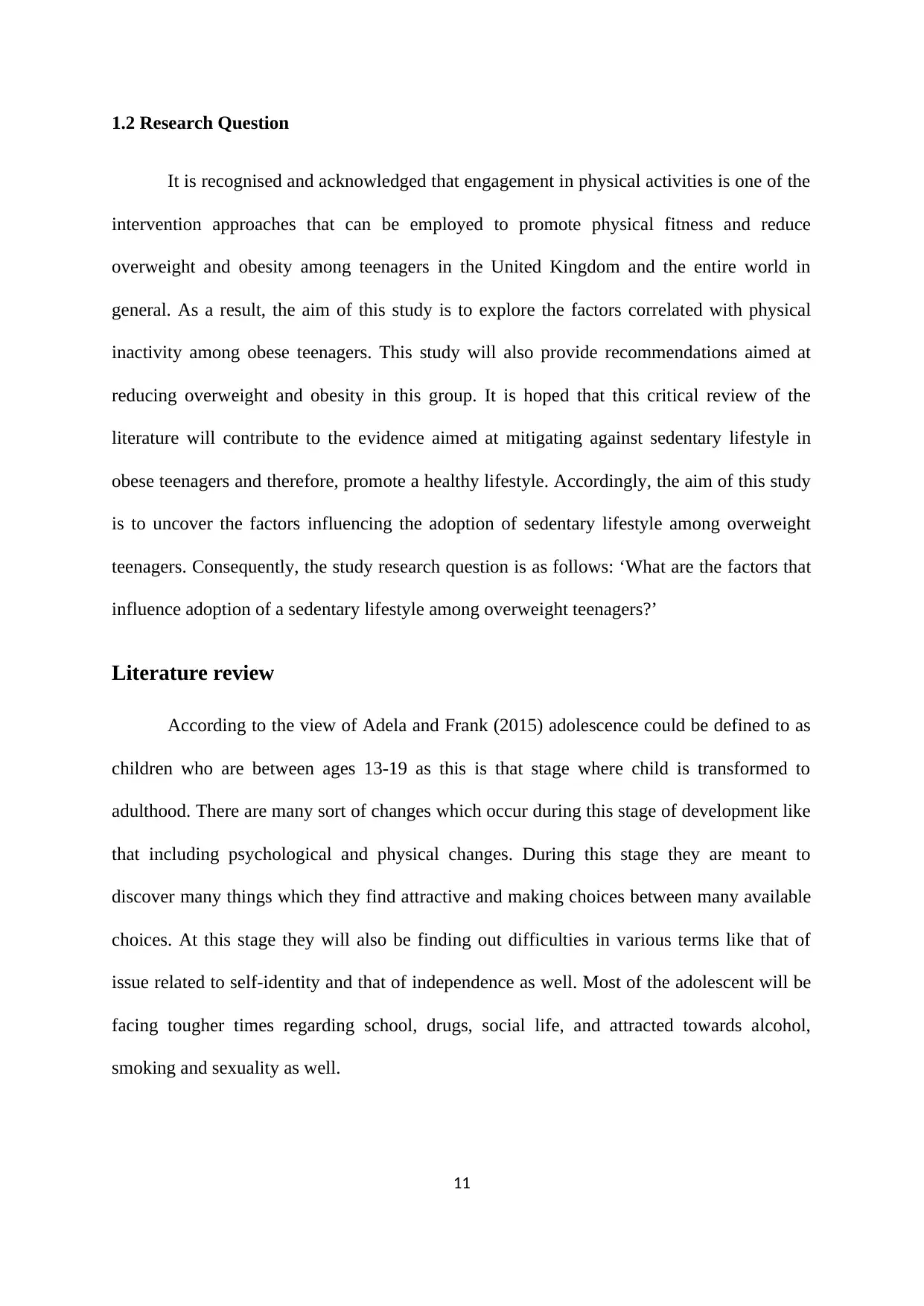
1.2 Research Question
It is recognised and acknowledged that engagement in physical activities is one of the
intervention approaches that can be employed to promote physical fitness and reduce
overweight and obesity among teenagers in the United Kingdom and the entire world in
general. As a result, the aim of this study is to explore the factors correlated with physical
inactivity among obese teenagers. This study will also provide recommendations aimed at
reducing overweight and obesity in this group. It is hoped that this critical review of the
literature will contribute to the evidence aimed at mitigating against sedentary lifestyle in
obese teenagers and therefore, promote a healthy lifestyle. Accordingly, the aim of this study
is to uncover the factors influencing the adoption of sedentary lifestyle among overweight
teenagers. Consequently, the study research question is as follows: ‘What are the factors that
influence adoption of a sedentary lifestyle among overweight teenagers?’
Literature review
According to the view of Adela and Frank (2015) adolescence could be defined to as
children who are between ages 13-19 as this is that stage where child is transformed to
adulthood. There are many sort of changes which occur during this stage of development like
that including psychological and physical changes. During this stage they are meant to
discover many things which they find attractive and making choices between many available
choices. At this stage they will also be finding out difficulties in various terms like that of
issue related to self-identity and that of independence as well. Most of the adolescent will be
facing tougher times regarding school, drugs, social life, and attracted towards alcohol,
smoking and sexuality as well.
11
It is recognised and acknowledged that engagement in physical activities is one of the
intervention approaches that can be employed to promote physical fitness and reduce
overweight and obesity among teenagers in the United Kingdom and the entire world in
general. As a result, the aim of this study is to explore the factors correlated with physical
inactivity among obese teenagers. This study will also provide recommendations aimed at
reducing overweight and obesity in this group. It is hoped that this critical review of the
literature will contribute to the evidence aimed at mitigating against sedentary lifestyle in
obese teenagers and therefore, promote a healthy lifestyle. Accordingly, the aim of this study
is to uncover the factors influencing the adoption of sedentary lifestyle among overweight
teenagers. Consequently, the study research question is as follows: ‘What are the factors that
influence adoption of a sedentary lifestyle among overweight teenagers?’
Literature review
According to the view of Adela and Frank (2015) adolescence could be defined to as
children who are between ages 13-19 as this is that stage where child is transformed to
adulthood. There are many sort of changes which occur during this stage of development like
that including psychological and physical changes. During this stage they are meant to
discover many things which they find attractive and making choices between many available
choices. At this stage they will also be finding out difficulties in various terms like that of
issue related to self-identity and that of independence as well. Most of the adolescent will be
facing tougher times regarding school, drugs, social life, and attracted towards alcohol,
smoking and sexuality as well.
11
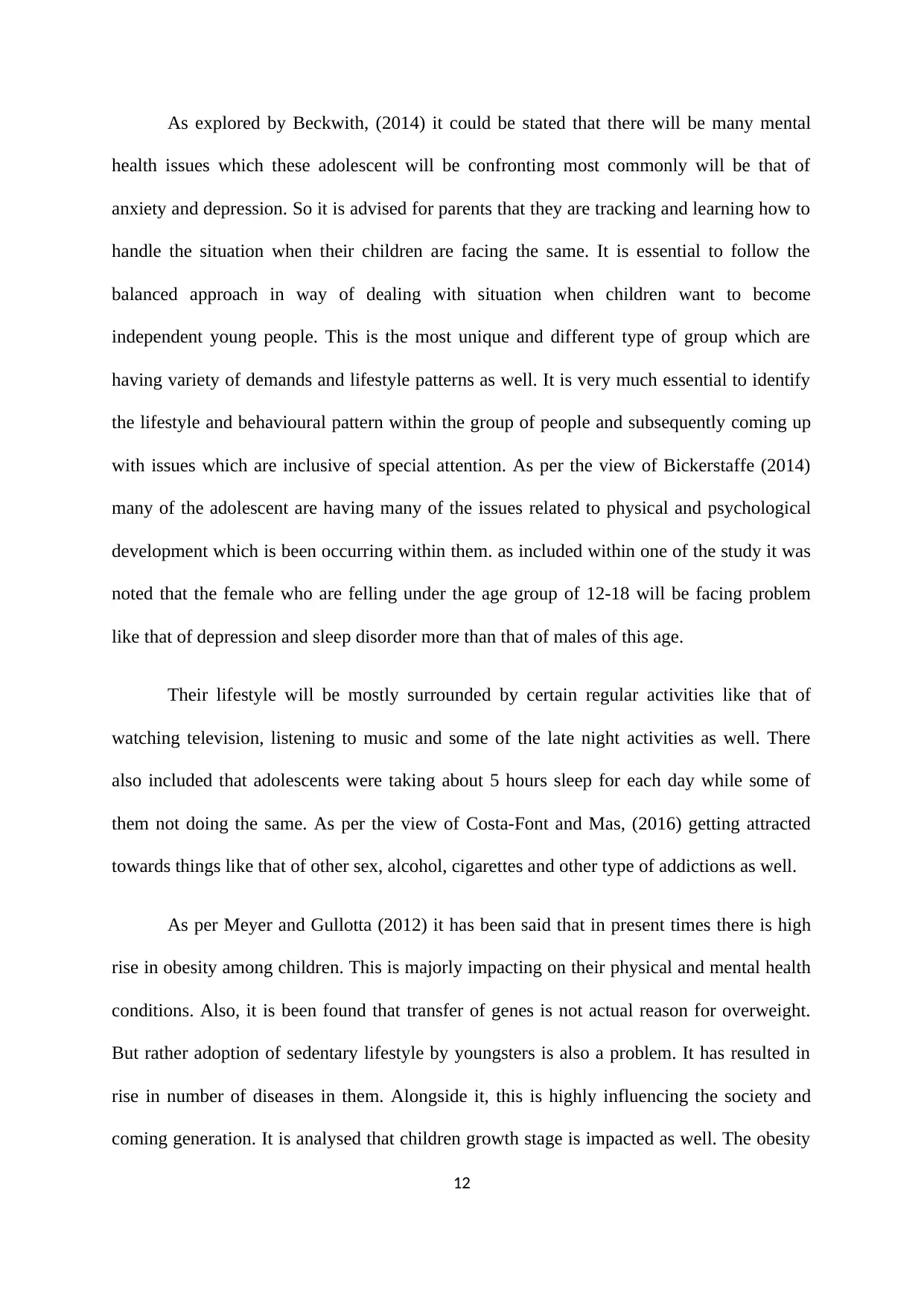
As explored by Beckwith, (2014) it could be stated that there will be many mental
health issues which these adolescent will be confronting most commonly will be that of
anxiety and depression. So it is advised for parents that they are tracking and learning how to
handle the situation when their children are facing the same. It is essential to follow the
balanced approach in way of dealing with situation when children want to become
independent young people. This is the most unique and different type of group which are
having variety of demands and lifestyle patterns as well. It is very much essential to identify
the lifestyle and behavioural pattern within the group of people and subsequently coming up
with issues which are inclusive of special attention. As per the view of Bickerstaffe (2014)
many of the adolescent are having many of the issues related to physical and psychological
development which is been occurring within them. as included within one of the study it was
noted that the female who are felling under the age group of 12-18 will be facing problem
like that of depression and sleep disorder more than that of males of this age.
Their lifestyle will be mostly surrounded by certain regular activities like that of
watching television, listening to music and some of the late night activities as well. There
also included that adolescents were taking about 5 hours sleep for each day while some of
them not doing the same. As per the view of Costa-Font and Mas, (2016) getting attracted
towards things like that of other sex, alcohol, cigarettes and other type of addictions as well.
As per Meyer and Gullotta (2012) it has been said that in present times there is high
rise in obesity among children. This is majorly impacting on their physical and mental health
conditions. Also, it is been found that transfer of genes is not actual reason for overweight.
But rather adoption of sedentary lifestyle by youngsters is also a problem. It has resulted in
rise in number of diseases in them. Alongside it, this is highly influencing the society and
coming generation. It is analysed that children growth stage is impacted as well. The obesity
12
health issues which these adolescent will be confronting most commonly will be that of
anxiety and depression. So it is advised for parents that they are tracking and learning how to
handle the situation when their children are facing the same. It is essential to follow the
balanced approach in way of dealing with situation when children want to become
independent young people. This is the most unique and different type of group which are
having variety of demands and lifestyle patterns as well. It is very much essential to identify
the lifestyle and behavioural pattern within the group of people and subsequently coming up
with issues which are inclusive of special attention. As per the view of Bickerstaffe (2014)
many of the adolescent are having many of the issues related to physical and psychological
development which is been occurring within them. as included within one of the study it was
noted that the female who are felling under the age group of 12-18 will be facing problem
like that of depression and sleep disorder more than that of males of this age.
Their lifestyle will be mostly surrounded by certain regular activities like that of
watching television, listening to music and some of the late night activities as well. There
also included that adolescents were taking about 5 hours sleep for each day while some of
them not doing the same. As per the view of Costa-Font and Mas, (2016) getting attracted
towards things like that of other sex, alcohol, cigarettes and other type of addictions as well.
As per Meyer and Gullotta (2012) it has been said that in present times there is high
rise in obesity among children. This is majorly impacting on their physical and mental health
conditions. Also, it is been found that transfer of genes is not actual reason for overweight.
But rather adoption of sedentary lifestyle by youngsters is also a problem. It has resulted in
rise in number of diseases in them. Alongside it, this is highly influencing the society and
coming generation. It is analysed that children growth stage is impacted as well. The obesity
12
⊘ This is a preview!⊘
Do you want full access?
Subscribe today to unlock all pages.

Trusted by 1+ million students worldwide
1 out of 48
Related Documents
Your All-in-One AI-Powered Toolkit for Academic Success.
+13062052269
info@desklib.com
Available 24*7 on WhatsApp / Email
![[object Object]](/_next/static/media/star-bottom.7253800d.svg)
Unlock your academic potential
Copyright © 2020–2025 A2Z Services. All Rights Reserved. Developed and managed by ZUCOL.




